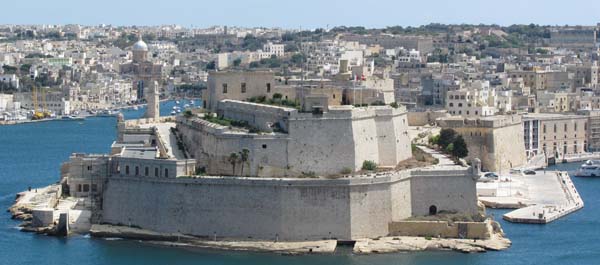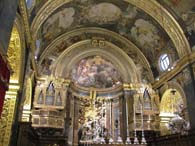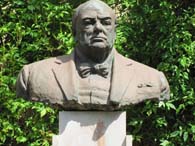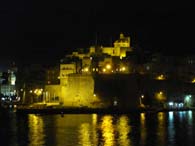A Journey to World War II Battlefields Part 3: The Siege of Malta

The third stop on our battlefield tour of Mediterranean battlefields was the island of Malta. Click here to see Part 1 and Part 2. After an overnight trip from Sousse, Tunisia, our cruise ship, the Corinthian II arrived in the harbor of Malta’s capital Valletta early the following afternoon. Situated in the central Mediterranean only slightly over 50 miles south of Sicily and 237 miles east of Tunisia, Malta has held strategic importance from medieval times through World War II, when it played an enormously important role in the struggle for control of the Mediterranean in 1941 and 1942.
{default}What strikes the first-time visitor to Malta is its brightly colored buildings made of stone, some of which are depicted in the photograph above. Because of its storied history Malta is an island of forts, churches and palaces. It is also the smallest and one of the most densely populated nations of the world, with some 368,000 people packed into its 316 sq. kilometers. It is also one of the cleanest places to visit. Valletta (and indeed the rest of Malta) is characterized by its pristine buildings, and streets that are free of trash or tawdry signage. With a temperate climate (an average of only thirteen days of rain a year), easy accessibility from places all over Europe and the Mediterranean, and its rich history and many historical sites, Malta, its smaller neighboring island of Gozo, and the tiny island of Comino (a bird sanctuary with only four permanent residents) have become popular tourist destinations. Valletta has a large modern airport to accommodate tourists.
The island has been a magnet for conquest for centuries. The first siege of Malta occurred in 1565 when an army of the Ottoman Empire invaded the island, which was under the control of the Knights Hospitaller (nicknamed the Knights of Malta), an important Christian order that dates to the Middle Ages. The order, which cared for pilgrims to the Holy Land who became ill or injured, is thought to have been founded about the year 1023. During the First Crusade, in 1099, the order was chartered as both a military and religious order. Their patron was St. John the Baptist and their most venerated leader was a French nobleman, Jean Parisot de la Valette, who led the resistance against the Ottoman siege in 1565. The island’s capital city is named in his honor and its dazzling stone buildings make Valletta a very attractive city.
 The importance of religion in Malta’s history is plainly evident from its 313 churches, and 46 in Gozo. The highlight of a visit to Valletta is St. John’s Co-Cathedral and Museum, whose exterior resembles a fortress but which has a beautiful interior that contains eight chapels and numerous paintings, including the famous masterpiece by Italian artist Michelangelo Merisi da Caravaggio (1571-1610), which depicts the beheading of St. John the Baptist. Buried in the floor of the nave are the richly ornate marble tombs of some of the most important knights of Malta.
The importance of religion in Malta’s history is plainly evident from its 313 churches, and 46 in Gozo. The highlight of a visit to Valletta is St. John’s Co-Cathedral and Museum, whose exterior resembles a fortress but which has a beautiful interior that contains eight chapels and numerous paintings, including the famous masterpiece by Italian artist Michelangelo Merisi da Caravaggio (1571-1610), which depicts the beheading of St. John the Baptist. Buried in the floor of the nave are the richly ornate marble tombs of some of the most important knights of Malta.
 In a small park overlooking the harbor of Valletta is a statue of Winston Churchill, who had a unique relationship with Malta and her people. During World War II he made it a top priority, almost to the point of obsession, to keep Malta resupplied and safely out of the hands of the Axis. During his more than forty years in public life, Churchill made six trips to Malta and in 1943 held a key meeting with his chiefs of staff en route to Teheran, and in 1945 he met there with Roosevelt prior to the Yalta Conference with Stalin.
In a small park overlooking the harbor of Valletta is a statue of Winston Churchill, who had a unique relationship with Malta and her people. During World War II he made it a top priority, almost to the point of obsession, to keep Malta resupplied and safely out of the hands of the Axis. During his more than forty years in public life, Churchill made six trips to Malta and in 1943 held a key meeting with his chiefs of staff en route to Teheran, and in 1945 he met there with Roosevelt prior to the Yalta Conference with Stalin.
Dedicated in 2004, the inscription on the statue reads: “To the Rt. Honorable Winston Spencer Churchill K.G. [from] the people of Malta and Gozo, MCMLV.”
The Siege of Malta during World War II
Virtually from the time war was declared on Britain and France in June 1940 by Mussolini, Malta came under attack from the air and naval forces of Fascist Italy and later from the Luftwaffe. Of all of the targets bombed during World War II, Malta was among the hardest hit and, given its location, was the most difficult to defend.
The Italian Air Force launched the first bombing raids on June 11, 1940. Malta had few anti-aircraft defenses and only three obsolete biplanes with which to defend itself. As the war progressed so too did the raids on Malta, particularly when the Luftwaffe began basing attack aircraft in nearby Sicily.
It was Hitler’s commander of air and land forces in the Mediterranean, a veteran airman and former artillery officer, Field Marshal Albert Kesselring, who unleashed the heavy air campaign against Malta. By 1941, with the arrival of Erwin Rommel’s German expeditionary force in Tripoli, the island had become like a bone in the throat of the Axis. What made Malta so strategically important was that the Royal Navy and Air Force could launch attacks against both Rommel and the Italian Army in North Africa and against German supply convoys. Quite early on, Rommel recognized that: “Without Malta the Axis will end by losing control of North Africa.” Rommel also argued that the German invasion of Crete was a mistake and that Malta ought to have been the target thus enabling the Axis rather than the British to control the Mediterranean Sea. Rommel even volunteered to lead an invasion of the island. Later he reflected on the failure to assault Malta, convinced that “given the number of troops for which I asked and proper support from the sea and air, I would have succeeded in taking the island fortress. With Malta in our hands, the British would have had little chance of exercising any further control over convoy traffic in the Central Mediterranean. Malta has the lives of many German and Italian soldiers on its conscience.” (B.H. Liddell Hart (ed.), The Rommel Papers, pp. 288-9.)
Given how badly Rommel required supplies in North Africa, his warnings and predictions were not the first time that he was ignored by Berlin. However, given that Hitler made Operation Barbarossa, the invasion of Russia in June 1941 his priority, operations in the Mediterranean were always secondary in importance and the invasion of Malta was never undertaken. Moreover, both Hitler and Göring were against invasion and believed that the continued aerial assault combined with a naval blockade were a sufficient alternative. Not for the first time would Hitler and Göring be proven wrong.
The heaviest attacks occurred in 1942. Malta was isolated, increasingly starved of supplies, and under aerial siege by Axis bombers that pounded the island, including thirteen raids in a single night in February 1942. Throughout February, 2,497 axis aircraft bombed Malta; in March that number doubled to 4,927 that saw an average of 159 sorties per day flown against the island. By April, an invasion was thought to be imminent, making Allied control of airfields in North Africa of signal importance to support the besieged island. Malta’s very survival was in question.
Winston Churchill feared that Malta would be “pounded to bits” but was determined to save it. Throughout the siege, Churchill was fixated with saving Malta and prepared “to run serious naval risks” to do so. He ordered British fighters deployed to Malta. Nevertheless, the valiant British pilots were generally outnumbered by about ten to one and with few supplies getting through; their aircraft were literally running on empty. At one point there were only six serviceable fighters with which to defend the island.
The air defense situation improved in May 1942 when, for the second time Roosevelt sent the carrier USS Wasp to Malta. The carrier escorted sixty Spitfires to the island, leading Churchill to cable the ship: “Many thanks to you. Who said a wasp couldn’t sting twice?” The effects were felt at once when thirty-seven German and Italian aircraft that attacked Malta failed to return to base, with a loss of only three Spitfires. (Martin Gilbert, Road to Victory: Winston S. Churchill, 1941-1945, p. 102.)
With no natural resources, to sustain itself the island had to import virtually all of its fuel, food and war supplies. By April 1942 Malta was on starvation rations and ammunition for its anti-aircraft guns was down to a handful of rounds per gun. Churchill directed that convoys make the hazardous trip through the waters of the Mediterranean to keep the island resupplied. However, during the two years between August 1940 and August 1942 only eighty-two ships were sent to Malta, of which thirty-one were sunk. By June, other than the arrival of the Spitfires, it had been nine months since a resupply convoy had gotten through.
The Luftwaffe continued launching air raids that rivaled those against London in 1940 and 1941. Indeed, in March and April 1942 it was bombed more heavily than London during the Blitz. Like Londoners, the citizens of Malta became like moles in the island’s underground shelters, caves and tunnels. The aerial attacks were relentless: from January 1, 1942 to July 24, there was only one day that Malta was not attacked from the air. In April 1942, in recognition of their heroic sacrifice, King George VI awarded the George Cross to the civilian population of the island. Henceforth, the George Cross became part of Malta’s flag.
The siege of Malta began to lift after Rommel was defeated at Alamein and officially ended in May 1943 when Axis forces in the Mediterranean surrendered on the plain of Tunis.
By failing to capture Malta the Axis paid a very heavy price. Well over 900 ships were sunk by the Allied navies and by mines with a loss of more than 17,000 lives. The Allied air forces sank another 1,300 ships. The price paid by the Maltese was equally high: shortages of food and water led to malnutrition, a typhoid epidemic, and a mounting toll of dead and wounded were all evidence of the terrible price paid by the islanders. More than 5,500 dwellings were destroyed and nearly 10,000 more damaged. In addition, fifty hospitals, 111 churches and numerous other buildings (some 30,000 in all) were damaged or destroyed.
 The visitor to Malta today will find no signs of Malta’s agony during World War II other than a few memorials and statues commemorating these events. There is also a small, popular National War Museum located in Valletta that depicts Malta’s role during World War II.
The visitor to Malta today will find no signs of Malta’s agony during World War II other than a few memorials and statues commemorating these events. There is also a small, popular National War Museum located in Valletta that depicts Malta’s role during World War II.
Any visitor with knowledge of the events of World War II will come away with a much deeper appreciation for its people and their great ordeal.
Our night departure from Valletta was impressive: the lights of the city reflect off the water, a far cry from the dark nights during the war.
Our destination was Sicily and a visit to the scenes of invasion in July 1943 and the airborne battles fought to save Operation Husky.


I would like to thank Mr. D’Este for his writeup on my country. Malta withstood the full brunt of the Axis attacks and more bombs fell on Malta than in the whole of the Battle of Britain. The courage shown by the Maltese were acknowledged by both the British – who awarded the highest civilian award for gallantry – the George Cross – and by the U.S> President Franklin Roosevelt’s who commented on Malta being ‘one tiny bright flame in darkness’. Malta’s has one of the richest military histories in the world – stretching from ancient times (Phoenicians, Cartaghinian, Romans etc), the famous Siege of Malta of 1565 against the Turks and all the way to the Napoleonic occupation, WWII and the Suez crisis. I would be more than willing to help out any contributor should he/she wish to review any aspect of Malta’s military involvement. thanks again to the D’Este couple. Pity I was not aware of their visit beforehand as I would have been honoured to provide any assitance – even if the D’Este’s article is superb as it stands.
Stephen Saliba
I am planning a Battlefield Study to Malta in March 2015 with a number of British Artillerymen and would like to get in touch with you.
One small issue I missed out and which should prove noteworthy.
US President George H. W. Bush and then Soviet President Mikhail Gorbachev met in Malta in December 1989 to seal the end of the USSR/West confrontation in what was then a very fast paced political scenario.
A few weeks later the Berlin wall fell.
As the saying goes.. the rest is history